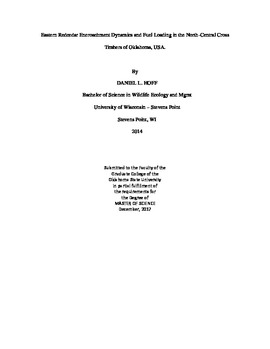| dc.contributor.advisor | Will, Rodney E. | |
| dc.contributor.author | Hoff, Daniel L. | |
| dc.date.accessioned | 2018-06-25T16:31:18Z | |
| dc.date.available | 2018-06-25T16:31:18Z | |
| dc.date.issued | 2017-12-01 | |
| dc.identifier.uri | https://hdl.handle.net/11244/300298 | |
| dc.description.abstract | Cross Timbers oak forests were historically the transition zone between the eastern deciduous forest and the southern Great Plains, and were typically dominated by Quercus stellata and Q. marilandica. The shift in human activity from lighting fires to suppressing them has caused a change in the composition and structure of the Cross Timbers. Encroachment of eastern redcedar (ERC; Juniperus virginiana) into the Quercus-dominated region is an ongoing management issue which affects ecosystem services and wildfire danger. The location and density of J. virginiana in the forest understory and midstory are important information for fire managers seeking to estimate the behavior of fires or anticipate resources and attack methods needed to contain wildland fires. We developed a method to use remotely sensed, 3-band, satellite imagery to determine ERC presence and abundance and estimate increased fuel loading within the Cross Timbers forest on 90 Bureau of Indian Affairs Indian Trust / tribal properties in Pawnee and Payne Counties Oklahoma, USA. To explore the dynamics of the encroachment of J. virginiana into the Cross Timbers we used 130 field verification plots to ground truth our imagery and assess the current composition and structure of trust properties. The image analysis was successful in detecting presence and abundance and useful in estimating increased fuel loading. Juniperus virginiana averaged 21% canopy cover within the forest matrix and added 6.3 Mg ha-1 to the fuel loading, a 38% increase. When cataloging field plots we found Q. stellata dominated the tree layer, but was at low frequency in the sapling and seedling layers. Quercus marilandica was present in very small quantities despite its reputation as a historically dominant tree. Increment cores collected from mature trees indicated that Quercus recruitment has been declining since the 1950’s while J. virginiana and fire-intolerant hardwood recruitment has been increasing. The fire-intolerant, more mesic species, exhibited significantly higher growth rates than Quercus and Juniperus species. The densification of the Cross Timbers by fire-intolerant species and J. virginiana will have significant effects on future fire behavior, future fire regimes and restoration potential as well as the future composition and structure of the Cross Timbers. | |
| dc.format | application/pdf | |
| dc.language | en_US | |
| dc.rights | Copyright is held by the author who has granted the Oklahoma State University Library the non-exclusive right to share this material in its institutional repository. Contact Digital Library Services at lib-dls@okstate.edu or 405-744-9161 for the permission policy on the use, reproduction or distribution of this material. | |
| dc.title | Eastern Redcedar Encroachment Dynamics and Fuel Loading in the North-central Cross Timbers of Oklahoma, Usa. | |
| dc.contributor.committeeMember | Zou, Chris B. | |
| dc.contributor.committeeMember | Gregory, Mark | |
| dc.contributor.committeeMember | Weir, John | |
| osu.filename | Hoff_okstate_0664M_15436.pdf | |
| osu.accesstype | Open Access | |
| dc.description.department | Natural Resources and Ecology Management | |
| dc.type.genre | Thesis | |
| dc.type.material | text | |
